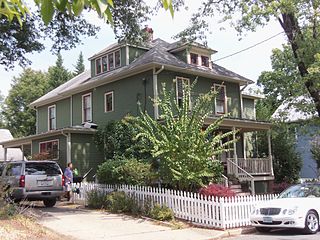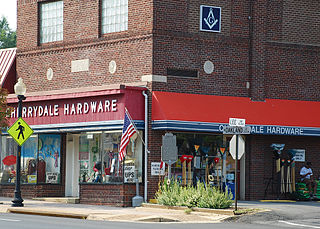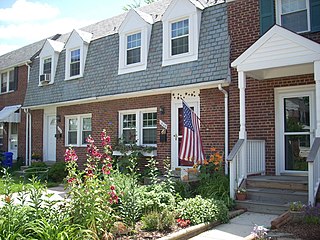
Lyon Village is a neighborhood, or "urban village" located in Arlington County, Virginia, along Langston Boulevard. It adjoins Arlington County's government center, and is approximately one mile west of Rosslyn and less than a mile north of Clarendon, of which it is sometimes considered a sub-neighborhood, as is Cherrydale, the mostly residential district immediately west of Lyon Village.

Arlington Ridge is a neighborhood in Arlington County, Virginia, United States. It is bordered on the north by The Pentagon, on the west by the Army Navy Country Club, and on the south the City of Alexandria. The main thoroughfare is the eponymous Arlington Ridge Road, a mansion-lined boulevard that, due to its high elevation, offers picturesque views of Washington, D.C., and the surrounding areas. Also known simply as "The Ridge", this community is home to two historical points of interest: the Hume School, currently the site of the Arlington Country Historical Society and Museum, and Fort Scott, currently the site of Fort Scott Park.

The Virginia Heights Historic District is a national historic district located at Arlington County, Virginia. It is directly west of the Columbia Forest Historic District. It contains 117 contributing buildings in a residential neighborhood in southwestern Arlington. The area was developed between 1946 and 1952, and consists of four small subdivisions of Section Four of Columbia Forest, High Point, Virginia Heights, and Frederick Hill. The dwelling styles include Colonial Revival style houses and Modernist twin dwellings designed by noted local architect Charles M. Goodman. In addition, five single dwellings in Virginia Heights are known to be prefabricated houses, three of which are Lustron houses.
The Penrose Historic District is a national historic district located at Arlington County, Virginia. It contains 486 contributing buildings, 2 contributing sites, and 2 contributing object in a residential neighborhood in South Arlington. The area was created with the integration of 12 distinct subdivisions platted between 1882 and 1943. The dwelling styles include the late-19th and early-20th-century vernacular, Queen Anne, Italianate, and Colonial Revival farm dwellings. A notable number of these dwellings are prefabricated kit or mail-order houses.

The Waverly Hills Historic District is a national historic district located at Arlington County, Virginia. It contains 439 contributing buildings in a residential neighborhood in North Arlington. The area is the result of the combination of five separate subdivisions platted for development between 1919 and 1939. The dwelling styles include a variety of architectural styles, including Tudor Revival, Colonial Revival, Dutch Colonial Revival, Bungalow / Craftsman, and Cape Cods. Located within the district is the separately listed Glebe House.

The Maywood Historic District is a national historic district located in Arlington County, Virginia. It contains 198 contributing buildings in a residential neighborhood located in the northern part of the county. The area was platted and subdivided in five sections between 1909 and 1913 following the arrival in 1906 of the Great Falls and Old Dominion Railroad. The area was primarily developed between 1909 and 1929. The dwelling styles include a variety of architectural styles, including Queen Anne, Colonial Revival foursquares, Bungalow, and two-story gable-front houses. Several dwellings in the neighborhood have been identified as prefabricated mail-order houses.

The Lyon Park Historic District is a national historic district and upper-class neighborhood located in Arlington County, Virginia. It contains 1,165 contributing buildings and 1 contributing site in a residential neighborhood in North Arlington. The area was platted between 1919 and 1951. The dwelling styles include a variety of architectural styles, ranging from Craftsman-style bungalows dating from the 1920s to Colonial Revival-style buildings dating from the 1930s and 1940s. A number of Queen Anne style dwellings erected prior to the platting of Lyon Park are also present. It was developed by Frank Lyon.

The Glencarlyn Historic District is a national historic district located in the Glencarlyn neighborhood of Arlington County, Virginia. It contains 276 contributing buildings, two contributing sites, one contributing structure, and one contributing object in a residential neighborhood in South Arlington. The area was platted in 1887 as Carlin Springs and continued to develop throughout the 20th century as a residential subdivision. The dwelling styles include a variety of architectural styles, ranging from Craftsman-style bungalows, Colonial Revival–style, and Queen Anne style dwellings. Notable buildings and sites include the Carlin Family Cemetery, Glencarlyn Library, and St. John's Episcopal Church. Also located in the district are the separately listed Ball-Sellers House and Carlin Hall.

The Cherrydale Historic District is a national historic district located in the Cherrydale neighborhood of Arlington County, Virginia. It contains 948 contributing buildings, 1 contributing site, 2 contributing structures, and 1 contributing object in a residential neighborhood in northern Arlington. The area was platted in 1898, with the majority of dwellings constructed in the second quarter of the 20th century. The dwelling styles include a variety of architectural styles, including a number of Colonial Revival and Queen Anne style dwellings. Also located in the district is the separately listed Cherrydale Volunteer Fire House.

Ashton Heights Historic District is a national historic district located in Arlington County, Virginia. Today, the Ashton Height Historic District contains 1,097 contributing buildings, one contributing site, and one contributing structure in a residential neighborhood in North Arlington.

The Arlington Heights Historic District is a national historic district located at Arlington County, Virginia. It contains 737 contributing buildings and 1 contributing site in a residential neighborhood in central Arlington. The area was formed from the integration of twenty-five subdivisions platted between 1909 and 1978. Single-family dwellings include representative examples of the Tudor Revival and Colonial Revival styles. The district is primarily a single-family residential neighborhood with a number of twin dwellings, is also home to garden apartments, one high-rise apartment building, a commercial building, a synagogue, a parsonage, a middle school with community center, and two landscaped parks.

The Arlington Village Historic District is a national historic district located at Arlington County, Virginia. It contains 657 contributing buildings in a residential neighborhood in South Arlington. The area was constructed in 1939, and is a planned garden apartment community that incorporates recreational areas, open spaces, a swimming pool and courtyards within five superblocks. It also includes a shopping center consisting of six stores. The garden apartments are presented as two-story, brick rowhouses with Colonial Revival detailing. There are three building types distinguished by the roof form: flat, gambrel, or gable. Arlington Village was the first large-scale rental project in Arlington County and the first Federal Housing Administration-insured garden apartment development. It was listed on the National Register of Historic Places in 2008.

The Lee Gardens North Historic District, also known as Woodbury Park Apartments, is a national historic district located at Arlington County, Virginia. It contains thirty attached masonry structures forming seven contributing buildings in a residential neighborhood in north Arlington. The garden apartment complex was designed by architect Mihran Mesrobian according to the original standards promoted by the Federal Housing Administration (FHA). The Lee Gardens North complex was completed in 1949–1950. The brick buildings are in the Colonial Revival style, with some fenestration elements influenced by the Art Deco and Moderne style.

The Westover Historic District is a national historic district located at Westover, Arlington County, Virginia. It contains 383 contributing buildings and 1 contributing site in a residential neighborhood in northern Arlington. The neighborhood was constructed in five phases between 1939 and 1957: Westover Apartments, Westover Hills, Keene's Addition to Westover, Westover Park, and Mason's Addition to Westover. The neighborhood consists of Colonial Revival-style single-family dwellings, twin houses, duplexes, and multi-family garden apartments. Also in the district are a shopping center, the Claude A. Swanson Junior High School, the Westover Baptist Church, and Swanson Park.

The Glebewood Village Historic District is a national historic district located at Arlington County, Virginia. It contains 105 contributing buildings in a residential neighborhood in northern Arlington. It was built between 1937 and 1938, and consists of seven individual blocks of Colonial Revival-style rowhouses. Each block consists of between 2 and 39 single rowhouse dwellings. Each rowhouse is two stories in height, two bays wide, of brick construction and capped with an asymmetrical side-gabled roof.

The Columbia Forest Historic District is a national historic district located at Arlington County, Virginia. It is directly east of the Virginia Heights Historic District. It contains 238 contributing buildings in a residential neighborhood in South Arlington. They were built in two phases beginning in 1942 and ending in 1945, and consist of 233 single-family dwellings contracted by the Federal government to house the families of young officers and ranking officials. They are two-story, two- and three-bay, paired brick or concrete block dwellings in the Colonial Revival-style. They were built under the direction of the Army Corps of Engineers by the Defense Housing Corporation.

The Monroe Courts Historic District is a national historic district located at Arlington County, Virginia. It contains 39 contributing buildings in a residential neighborhood in northern Arlington. They were built in 1938, and consist of four groups of two-story, two-bay, rowhouse dwellings in a vernacular Colonial Revival-style. They were built for a middle-class clientele in a fast-growing commuter suburb of Washington, D.C.

Highland Park–Overlee Knolls, also known as Fostoria, is a national historic district located in Arlington County, Virginia. It is directly east of the Virginia Heights Historic District. It contains 681 contributing buildings, 3 contributing sites, and 1 contributing structure in a residential neighborhood in North Arlington. The first subdivision was platted in 1890 and known as Fostoria.

Dominion Hills Historic District is a national historic district located at Arlington County, Virginia. It contains 446 contributing buildings in a residential neighborhood in western Arlington. It was platted in 1942 and developed between 1945 and 1948. It was designed to attract working and middle-income residents and is composed exclusively of two-story Colonial Revival style dwellings.
Arlington County Board v. Richards, 434 U.S. 5 (1977), is a United States Supreme Court decision on the application of the Equal Protection Clause of the Fourteenth Amendment to the Constitution to municipal parking restrictions. In a unanimous per curiam opinion, the Court held that a residential zoned parking system requiring permits for daytime parking in the Aurora Highlands neighborhood of Arlington County, Virginia, with those permits limited to residents, their guests and those who came to their homes for business purposes had a rational basis and was thus constitutional. Its decision overturned the Virginia Supreme Court.
























